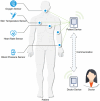Provably secure and lightweight blockchain based cross hospital authentication scheme for IoMT-based healthcare
- PMID: 39987251
- PMCID: PMC11846994
- DOI: 10.1038/s41598-025-90219-5
Provably secure and lightweight blockchain based cross hospital authentication scheme for IoMT-based healthcare
Abstract
Portable devices and sensors-based Internet of Medical Things (IoMT) healthcare can remotely detect patients' physiological data and provide first-class healthcare services. However, the high privacy and sensitivity of medical data make IoMT healthcare systems vulnerable to various attacks. While numerous authentication protocols have been introduced in recent years to guarantee authorized access, these schemes continue to face challenges such as privacy disclosure, untraceability of malicious behavior, insufficient cross-hospital access, and concerns related to single points of failure and trust. To address these issues, we propose a Double Anonymity Strategy to hide identities between doctors and the patients while allowing the authorized party to track their malicious behavior, enhance users' privacy and track malicious users. Our approach leverages the advantages of blockchain, such as decentralization, and replaces trusted third parties with smart contracts for efficient and automatic identity authentication. Additionally, we introduce a cross-hospital authentication scheme that incorporates three-factor secrecy, ensuring that even if any two of the three factors (device, biometric information and password) are compromised, the security of the proposed scheme will not be affected. The security of our scheme is formally proven under the random oracle model, which formally measures that the probability of an adversary breaking the scheme is negligible. We also provide informal security analysis showing that our scheme prevents privacy breaches, achieves decentralization, and addresses existing various attacks. Furthermore, through simulation of the proposed scheme and comparison with related works, we demonstrate that our scheme achieves 23% to 87% reduction in computational cost while maintaining higher security properties.
Keywords: Authentication protocol; Blockchain; Cross-hospital; Decentralization; Healthcare; Internet of Medical Things.
© 2025. The Author(s).
Conflict of interest statement
Declarations. Competing interests: The authors declare no competing interests.
Figures







Similar articles
-
Blockchain Enabled Anonymous Privacy-Preserving Authentication Scheme for Internet of Health Things.Sensors (Basel). 2022 Dec 26;23(1):240. doi: 10.3390/s23010240. Sensors (Basel). 2022. PMID: 36616838 Free PMC article.
-
An Efficient User Authentication and User Anonymity Scheme with Provably Security for IoT-Based Medical Care System.Sensors (Basel). 2017 Jun 23;17(7):1482. doi: 10.3390/s17071482. Sensors (Basel). 2017. PMID: 28644381 Free PMC article.
-
Leveraging blockchain and IoMT for secure and interoperable electronic health records.Sci Rep. 2025 Apr 10;15(1):12358. doi: 10.1038/s41598-025-95531-8. Sci Rep. 2025. PMID: 40211028 Free PMC article.
-
Design of a Secure Medical Data Sharing Scheme Based on Blockchain.J Med Syst. 2020 Jan 8;44(2):52. doi: 10.1007/s10916-019-1468-1. J Med Syst. 2020. PMID: 31915982 Review.
-
A Comparative Analysis on Blockchain versus Centralized Authentication Architectures for IoT-Enabled Smart Devices in Smart Cities: A Comprehensive Review, Recent Advances, and Future Research Directions.Sensors (Basel). 2022 Jul 10;22(14):5168. doi: 10.3390/s22145168. Sensors (Basel). 2022. PMID: 35890848 Free PMC article. Review.
Cited by
-
Machine Learning-Powered Smart Healthcare Systems in the Era of Big Data: Applications, Diagnostic Insights, Challenges, and Ethical Implications.Diagnostics (Basel). 2025 Jul 30;15(15):1914. doi: 10.3390/diagnostics15151914. Diagnostics (Basel). 2025. PMID: 40804880 Free PMC article. Review.
References
-
- Xie, Q. et al. Improvement of a uniqueness-and-anonymity-preserving user authentication scheme for connected Health Care. J. Med. Syst.10.1007/s10916-014-0091-4 (2014). - PubMed
-
- Xie, Q., Hu, B. & Wu, T. Improvement of a chaotic maps-based three-party password-authenticated key exchange protocol without using server’s public key and smart card. Nonlinear Dyn.79, 2345–2358 (2014).
-
- Mettler, M. Blockchain technology in Healthcare: The revolution starts here. In 2016 IEEE 18th International Conference on e-Health Networking, Applications and Services (Healthcom)10.1109/healthcom.2016.7749510 (2016).
-
- Sullivan, C. & Burger, E. E-residency and blockchain. Comput. Law Security Rev.33, 470–481 (2017).
-
- Srivastava, G., Parizi, R. M., Dehghantanha, A. & Choo, K.-K. R. Data sharing and privacy for patient IoT devices using blockchain. In International Conference on Smart City and Informatization. 334–348 (2019).
MeSH terms
Grants and funding
LinkOut - more resources
Full Text Sources

